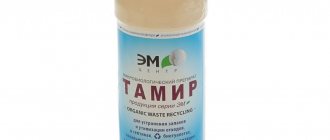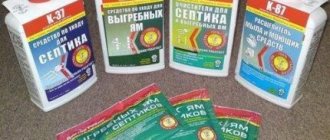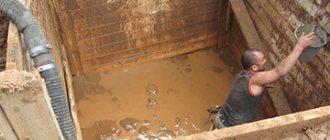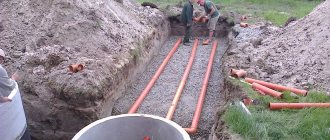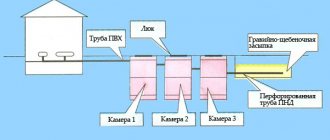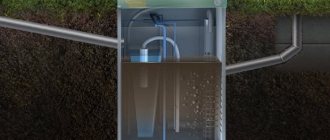What you need to know about biobacteria for sewage
They are divided into two types:
- aerobic - live and feed in the presence of oxygen;
- anaerobic - can only live in an airless environment.
Healthy! Anaerobes are one of the most ancient types of microorganisms that once dominated the planet.
It is possible to use such a cleaning system, but then the outlet liquid must be further purified with mechanical filters.
Currently, they live only in bottom silt, swamps, and deep layers of soil. By decomposing the remains of animals and plants, microbes break them down into methane and mineral sediment and “make” humus - a fertile layer of soil, as well as peat.
Canning is lactic acid fermentation, which includes fermentation and silage making. They live in a liquid environment.
Aerobes need oxygen - if they find themselves in a closed container, they need air pumping from the outside. They live in humid and liquid environments saturated with oxygen and are very afraid of antibiotics, aggressive cleaning agents, and chlorine. Because of this feature, the first blow in purification is taken by anaerobes, and further processing is carried out by aerobes - that is, purification follows a combined scheme.
Important! The bacterial strains obtained in the laboratory have increased survivability and the ability to work in an aggressive environment.
Pond care
Another option for using anaerobic or aerobic microbes is to clean water bodies, particularly garden ponds. Unlike large natural reservoirs, where biological balance can be restored by itself, small ponds in garden plots require careful maintenance. An excess of organic substances in water quickly leads to cloudiness and mustiness. Both of these can be avoided by adding a preparation containing microorganisms to the pond.
As a result, a special reagent first collects pollutants in flakes that settle to the bottom. And here they are already taken to be bacteria contained in the same preparation, which decompose organic matter. At the same time, the cleaning bacteria “go into hibernation” during the winter, and in the spring they begin their work again.
All these drugs are absolutely harmless to humans and all pond inhabitants. The main thing to remember is that microorganisms will work most effectively only in closed reservoirs (there is no inflow or outlet of water).
It is necessary to create favorable conditions for biobacteria
Your system will work smoothly if you follow simple rules:
- Correctly calculate the required volume (depending on the number of residents and devices in the house, as well as the area of the site and the water being drained). If the storage tank is too small, it will need to be cleaned of solid sediment too often.
- The system must be used regularly. Without wastewater to feed them, the bacteria will die in 3-4 days.
- Resistant bacteria that are not afraid of chemicals at all still do not exist. Even special strains die or are inhibited by chlorine, formaldehyde, aggressive acids and alkalis, antibiotics, and petroleum products. Therefore, you should be careful about the composition of household wastewater and carefully choose detergents. It is better to choose even washing machine and dishwasher powder taking this parameter into account. The recommended water acidity level (pH) is from 4 to 10.
- The optimal temperature inside the drive is from 10 to 35 degrees. This can play a role in winter, so take care of thermal insulation and deep laying of the tank, as well as additional cooling of excessively hot domestic wastewater.
- Leaching can be a big problem. Bacteria will linger in the septic tank if crushed stone, gravel, blast furnace slag, and anthracite are added to the bottom and walls. Polymer materials have proven themselves well in biological treatment tanks. Brushes, meshes made from them, as well as fleecy materials placed freely in the volume, increase cleaning efficiency by up to 90% (versus 25% for crushed stone).
- Depending on the operating mode, on average once every 1–3 years it is necessary to remove solid sediment from the bottom. Anaerobic substances require a liquid to sediment ratio in the settling tank of at least 2 to 1.
- Approximately once every 2 months, a portion of the bioactivator is added to the sewer to maintain the colonies.
- It is necessary to clean the drainage systems on the site with water under pressure, and wash the biological filter approximately once every six months to remove sediment accumulated on the walls.
Accelerated compost maturation
All summer residents and gardeners know about the benefits of good compost. However, it takes several years for a good fertilizer to mature under normal conditions. And here again bacteria come to the rescue, significantly accelerating this process.
By adding biological accelerators to the compost heap, you can put almost any waste (organic) there without grinding it. The main aerobic conditions for accelerating the process are the alternation of garden and kitchen waste and constant access of oxygen. Such composting helps to reduce the time for preparing fertilizer several times and makes the work of the gardener easier (there is no need to finely chop waste and build several compost heaps).
What and where to pour and top up
Drugs are added directly to the storage tank through the hatch or poured into the sewer. Depending on the composition, the following classes of activators can be found:
- " Starters ". Forms naturally in tanks for up to 2 weeks. They can be helped by increasing the “starting” number. This is also true after a cold winter or a long departure, when the sewage system was not used and the colony could die. Also, the starting mixture is regularly added as usual.
- " Strengthened ". They are used in a cycle to combat heavy pollution, then you can switch back to the “starter” ones.
- " Special ". Designed to break down one type of contamination. For example, greasy film or soap residue.
Features of DNA in aerobes and anaerobes
It is believed that anaerobic forms of life preceded aerobic ones. As oxygen accumulated in the atmosphere, the richness and diversity of bacteria increased all the time. It was noticed that simpler microorganisms without cytochromes have a different DNA composition - the bases Adenine and Thymine predominate in the molecule. Later and more evolutionarily developed forms have cytochromes, and the genetic material contains more bases Guanine and Cytosine. Some anaerobic organisms do not have a clearly defined nucleus, and DNA is found in the form of a nucleoid in the cytoplasm.
Where to buy bio drugs and how to use them
In the form of granules, tablets, liquids, they are poured into the sewer system or directly into a container and filled with plenty of water. The amount of activator depends on the volume of the tank.
Application area:
- septic tanks;
- cesspools;
- biotoilets.
For the last two, products with additional flavors are relevant. Average consumption 50 g per 1 m3. The bioactivator is normally topped up at least 2 times a month. After using aggressive chemicals (chlorine-containing preparations), living bacteria are suppressed, and additional supplements are also needed.
Tableted substances are usually calculated as 1 piece. per 1 m3. Liquid products - 0.5 liters per 1 m3, it is better to shake them first, pour them into warm non-chlorinated water, let them dissolve, then shake them and pour them down the drain.
Here is a rating of popular tools:
"Doctor Robik"
Country of origin: Ukraine.
Starter package – 75 g (per 2000 l), designed for a month of work. Retail price – from 150 rubles.
The brand also produces specials. products in liquid form - volume 800 ml and validity period of 1 year. 700–800 rub.
Kinds:
- “309” – basic in liquid form;
- “409” – for septic tanks and drainages;
- “509” – for liquefying thick, unrefined mass;
- “609” – clearing blockages;
- “809” – removal of soap scum in a septic tank and build-up in pipes.
Classification division of prokaryotes
The species diversity of these anucleate, single-celled organisms is enormous: science has described only 10,000 species, but it is believed that there are more than a million species of bacteria. Their classification is extremely complex and is carried out based on the commonality of the following features and properties:
- morphological – shape, mode of movement, ability to form spores, etc.);
- physiological - breathing oxygen (aerobic) or oxygen-free version (anaerobic bacteria), by the nature of metabolic products and others;
- biochemical;
- similarity of genetic characteristics.
For example, morphological classification by appearance divides all bacteria as:
- rod-shaped;
- tortuous;
- spherical.
The physiological classification in relation to oxygen divides all prokaryotes into:
- anaerobic – microorganisms whose respiration does not require the presence of free oxygen;
- aerobic - microorganisms that require oxygen for their vital functions.
Differential - diagnostic nutrient media
- Hiss
media (“variegated row”)
Russell 's medium- Endo environment
- Ploskirev's
medium or
Bactoagar "Zh" - Bismuth sulfite agar
Hiss media
: To 1% peptone water add a 0.5% solution of a certain carbohydrate (glucose, lactose, maltose, mannitol, sucrose, etc.) and Andrede’s acid-base indicator, pour into test tubes in which a float is placed to catch gaseous products formed during decomposition of hydrocarbons.
Russell's environment
(Russell) is used to study the biochemical properties of enterobacteria (Shigella, Salmonella). Contains nutrient agar agar, lactose, glucose and indicator (bromothymol blue). The color of the environment is grassy green. Usually prepared in 5 ml test tubes with a beveled surface. Sowing is carried out by pricking into the depth of the column and streaking along the beveled surface.
Endo environment
Wednesday Ploskireva
(bactoagar F) is a differential diagnostic and selective medium, since it inhibits the growth of many microorganisms and promotes the growth of pathogenic bacteria (causative agents of typhoid fever, paratyphoid fever, dysentery). Lactose-negative bacteria form colorless colonies on this medium, while lactose-positive bacteria form red colonies. The medium contains agar, lactose, brilliant green, bile salts, mineral salts, indicator (neutral red).
Bismuth sulfite agar
is intended for the isolation of salmonella in its pure form from infected material.
Contains tryptic hydrolyzate, glucose, Salmonella growth factors, brilliant green and agar. The differential properties of the medium are based on the ability of Salmonella to produce hydrogen sulfide and on their resistance to the presence of sulfide, brilliant green and bismuth citrate. Colonies are marked black with bismuth sulfide (a technique similar to Wilson-Blair
).
Content
- 1 Degree of aerobic environment
- 2 Classification of anaerobes
- 3 Toxicity of oxygen and its forms to anaerobic organisms
- 4 Obtaining energy by substrate phosphorylation. Fermentation. Rotting
- 5 Antagonism of fermentation and putrefaction
- 6 Cultivation of anaerobic organisms
- 7 Common culture media for anaerobic organisms
- 8 General culture methods for anaerobic organisms
- 9 Differential - diagnostic culture media
- 10 Metabolism of anaerobic organisms
- 11 Anaerobic energy metabolism in human
and
animal - 12 See also
- 13 Notes
- 14 Links
Energy production in human tissues
Some tissues of living organisms have increased resistance to low oxygen levels. Under standard conditions, adenosine triphosphate synthesis occurs aerobically, but with increased physical activity and inflammatory reactions, the anaerobic mechanism comes to the fore.
Adenosine triphosphate (ATP) is an acid that plays an important role in the body's production of energy. There are several options for the synthesis of this substance: one aerobic and three anaerobic.
Anaerobic mechanisms for ATP synthesis include:
- rephosphorylation between creatine phosphate and ADP;
- transphosphorylation reaction of two ADP molecules;
- anaerobic breakdown of blood glucose or glycogen reserves.
Links
- Arnold P. (2009). Examples of anaerobic bacteria. Retrieved from https://www.brighthub.com
- Rees, J. B., & Campbell, N. A. (2011). Campbell Biology. Boston: Benjamin Cummings/Pearson.
- Clostridium botulinum. (2013). US Department of Agriculture, Food Inspection and Safety. Retrieved from www.fsis.usda.gov
- Hoecker, J. (2015). How can I protect my child from infant botulism? Mayo Clinic. Retrieved from https://www.mayoclinic.org
- Taylor A. (2016). What makes Yellowstone's hot springs so colorful? Retrieved from https://www.livescience.com
Anaerobic infections
Most anaerobic bacteria living in the human or animal body can cause various infections. As a rule, infection occurs during a period of weakened immunity or disruption of the general microflora of the body. There is also the possibility of pathogens entering from the external environment, especially in late autumn and winter.
Infections caused by anaerobic bacteria are usually associated with the flora of human mucous membranes, that is, with the main habitats of anaerobes. As a rule, such infections have several pathogens (up to 10).
The exact number of diseases caused by anaerobes is almost impossible to determine due to the difficulty of collecting materials for analysis, transporting samples and cultivating the bacteria themselves. Most often, this type of bacteria is found in chronic diseases.
People of any age are susceptible to anaerobic infections. At the same time, children have a higher rate of infectious diseases.
Anaerobic bacteria can cause various intracranial diseases (meningitis, abscesses and others). Spread usually occurs through the bloodstream. In chronic diseases, anaerobes can cause pathologies in the head and neck area: otitis media, lymphadenitis, abscesses . These bacteria pose a danger to both the gastrointestinal tract and lungs. With various diseases of the female genitourinary system, there is also a risk of developing anaerobic infections. Various diseases of the joints and skin can be a consequence of the development of anaerobic bacteria.
Causes of anaerobic infections and their signs
All processes during which active anaerobic bacteria enter tissues lead to infections. Also, the development of infections can be caused by impaired blood supply and tissue necrosis (various injuries, tumors, edema, vascular diseases). Oral infections, animal bites, pulmonary diseases, pelvic inflammatory disease and many other diseases can also be caused by anaerobes.
The infection develops differently in different organisms. This is influenced by both the type of pathogen and the state of human health. Because of the difficulties associated with diagnosing anaerobic infections, the conclusion is often based on guesswork. non-clostridial anaerobes differ in some features .
The first signs of tissue infection by aerobes are suppuration, thrombophlebitis, and gas formation. Some tumors and neoplasms (intestinal, uterine and others) are also accompanied by the development of anaerobic microorganisms. With anaerobic infections, an unpleasant odor may appear, however, its absence does not exclude anaerobes as the causative agent of the infection.
Features of obtaining and transporting samples
The very first test in identifying infections caused by anaerobes is a visual examination. Various skin lesions are a common complication. Also, evidence of the vital activity of bacteria will be the presence of gas in infected tissues.
For laboratory tests and establishing an accurate diagnosis, first of all, it is necessary to correctly obtain a sample of matter from the affected area. To do this, they use a special technique, thanks to which normal flora does not get into the samples. The best method is straight needle aspiration. Obtaining laboratory material using the smear method is not recommended, but is possible.
Samples that are not suitable for further analysis include:
- sputum obtained by self-excretion;
- samples obtained during bronchoscopy;
- smears from the vaginal vaults;
- urine with free urination;
- feces.
The following can be used for research:
- blood;
- pleural fluid;
- transtracheal aspirates;
- pus obtained from the abscess cavity;
- cerebrospinal fluid;
- lung punctures.
Samples must be transported as quickly as possible in a special container or plastic bag under anaerobic conditions, since even short-term interaction with oxygen can cause the death of bacteria. Liquid samples are transported in a test tube or in syringes. Swabs with samples are transported in tubes with carbon dioxide or pre-prepared media.
Treatment of anaerobic infection
If an anaerobic infection is diagnosed, the following principles must be followed for adequate treatment:
- toxins produced by anaerobes must be neutralized;
- the habitat of bacteria should be changed;
- the spread of anaerobes must be localized.
To comply with these principles, antibiotics are used in treatment , which affect both anaerobes and aerobic organisms, since the flora in anaerobic infections is often mixed. At the same time, when prescribing medications, the doctor must evaluate the qualitative and quantitative composition of the microflora. Agents that are active against anaerobic pathogens include: penicillins, cephalosporins, clapamphenicol, fluoroquinolo, metronidazole, carbapenems and others. Some drugs have limited effect.
To control the habitat of bacteria, in most cases, surgical intervention is used, which involves treating affected tissues, draining abscesses, and ensuring normal blood circulation. Surgical methods should not be ignored due to the risk of life-threatening complications.
Sometimes auxiliary treatment methods , and because of the difficulties associated with accurately identifying the causative agent of the infection, empirical treatment is used.
When anaerobic infections develop in the oral cavity, it is also recommended to add as many fresh fruits and vegetables to the diet as possible. The most useful for this are apples and oranges. Meat foods and fast food are subject to restrictions.
References
- Clinical guidelines for the diagnosis and treatment of brain abscesses, intracranial epidural and subdural empyemas. Association of Neurosurgeons of Russia, 2015. - 28 p.
- Kupchenko, A.M., Kosinets, V.A. Identification and determination of antibacterial sensitivity of anaerobic microflora in the treatment of widespread purulent peritonitis. Surgery news, 2014. - No. 4. - pp. 457-462.
- Guilhot, E., Khelaifia, S., Scola, B. et al. Methods for culturing anaerobes from human specimen. Future microbiology, 2021. - Vol. 13. - P. 369-381.
